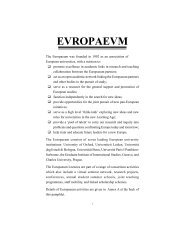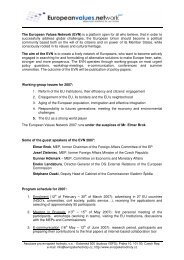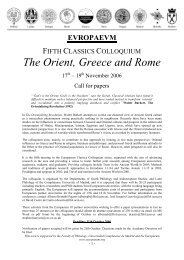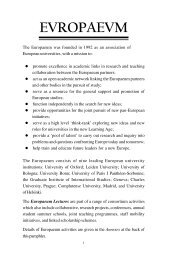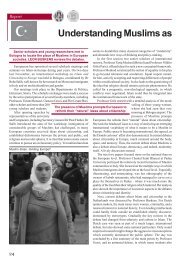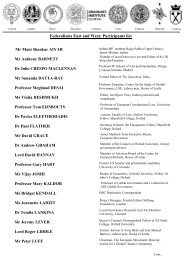Authors Iain Begg | Gabriel Glöckler | Anke Hassel ... - The Europaeum
Authors Iain Begg | Gabriel Glöckler | Anke Hassel ... - The Europaeum
Authors Iain Begg | Gabriel Glöckler | Anke Hassel ... - The Europaeum
Create successful ePaper yourself
Turn your PDF publications into a flip-book with our unique Google optimized e-Paper software.
was apparently not as compelling as anticipated by some and/or the<br />
supply was constrained by various political, institutional, economic and<br />
social factors.<br />
<strong>The</strong> one area where tangible progress in economic integration has been<br />
achieved is the financial markets. <strong>The</strong> functional explanation for this<br />
advance lies in the fact that the introduction of the single currency removes<br />
a key inefficiency in the functioning of financial markets in Europe:<br />
the need to deal with various national currencies. However, while the<br />
existence of a single currency may be a necessary condition of integrated<br />
financial markets, it is by no means a sufficient one. Indeed, as stressed in<br />
various reviews of the state of integration of financial markets in Europe,<br />
the integration progress is very uneven across the various segments of<br />
the market, with those segments that are closest to the single monetary<br />
policy – like the money markets – displaying the most advanced degree<br />
of integration. Private sector action that created facts on the ground (e.g.<br />
through cross-border banking mergers and acquisitions) and pressure on<br />
public policy have generated demand for further integration. On the supply<br />
side, an activist pro-integration stance from the European Commission<br />
and the ECB has driven progress towards deeper financial integration.<br />
<strong>The</strong> EU’s Financial Services Action Plan sought to address the existing<br />
obstacles to a truly integrated financial market in the EU.<br />
A surge in demand for EU policy action:<br />
the response to the financial crisis since summer 2007<br />
<strong>The</strong> 2007-2009 financial crisis led, prima facie, to a step-change in the<br />
demand for integration outcomes, at least among euro area member states. 8<br />
<strong>The</strong> stresses in the euro money market that occurred in August 2007 – by<br />
definition a fully integrated segment of the financial markets – meant that<br />
a supranational institution with a commensurate responsibility covering<br />
the entire currency zone, in this case the ECB, had to intervene to enable<br />
the continued fulfillment of its responsibilities, i.e. to ensure the orderly<br />
functioning of interbank money markets across the euro area, in order to<br />
guarantee the proper transmission of its monetary policy signal. This task<br />
is inherent in the ECB’s responsibility for the single monetary policy and<br />
its price stability mandate. Problems that emanated from specific financial<br />
institutions in certain euro area countries created spill-over effects in<br />
other countries due to the integrated nature of the euro money markets,<br />
engendering a policy response at the supranational level. In that sense,<br />
the functionalist logic drove the first public policy action in the course<br />
of the financial crisis. That said, at this stage, the market tensions had<br />
Chapter 3 – <strong>Gabriel</strong> Glöckler 47




